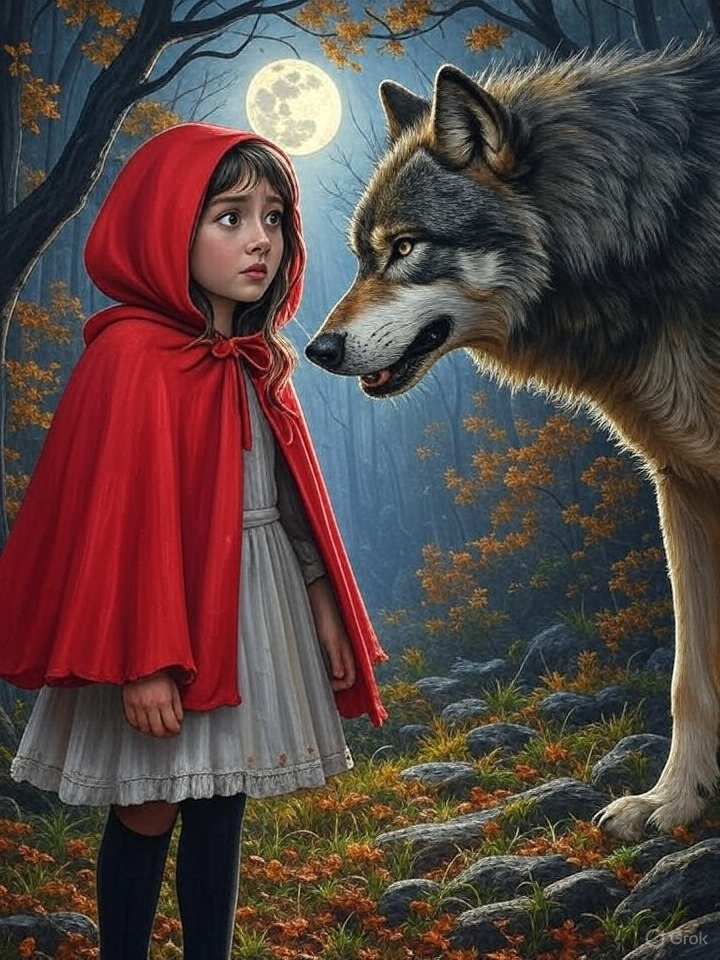Little Red Riding Hood
Once upon a time, there was a girl called Little Red Riding Hood. She lived with her mother in a small village. She always wore a red cape, and that's why people called her that.

One day, her mother said, "Please take this basket of food to your grandmother. She is sick and lives in the forest." Little Red Riding Hood nodded and started her journey.
As she walked through the forest, she met a big wolf. The wolf smiled and asked, "Where are you going, little girl?" She answered, "I'm going to my grandmother's house to bring her food." The cunning wolf thought, "I can eat the girl and her grandmother!" But he didn't say it.
The wolf said, "Let's see who gets there first!" Then he ran to the grandmother's house. When he arrived, he knocked on the door. The grandmother opened it, and the wolf quickly ate her! He put on her clothes and waited in her bed.
Soon, Little Red Riding Hood arrived. She saw her "grandmother" in bed and said, "Grandmother, what big eyes you have!" The wolf replied, "All the better to see you with!"
Then she said, "What big ears you have!" The wolf answered, "All the better to hear you with!"
Finally, she said, "What big teeth you have!" The wolf jumped up and said, "All the better to eat you with!" And he tried to catch her.
Luckily, a woodcutter was nearby. He heard the noise and ran into the house. With his axe, he saved Little Red Riding Hood and her grandmother by cutting the wolf open. The grandmother and the girl were safe! The woodcutter took the wolf away.
From that day, Little Red Riding Hood was more careful. She never talked to strangers in the forest again. And they all lived happily ever after.
The End.
Vocabulary Practice
Key words from the story:
- cape - a sleeveless cloak that hangs from the shoulders
- nodded - moved the head up and down to show agreement
- journey - a trip from one place to another
- cunning - clever in a dishonest or sneaky way
- knocked - hit a door with your knuckles to get attention
- replied - answered or responded to something said
- woodcutter - a person who cuts down trees for wood
- axe - a tool with a sharp blade for cutting wood
- nearby - close to this place; not far away
- strangers - people you don't know
Related Learning Materials
Grammar Topics
- Past Simple Tense - Learn the basic past tense structures used in this story
- Modal Verbs - Practice "can," "could," and "would" in context
- Reported Speech - Direct and indirect speech patterns from the story
Vocabulary Practice
- Beginner Vocabulary Page 4 - Family and safety vocabulary
- Intermediate Vocabulary Page 7 - Emotions and safety terminology
- Intermediate Vocabulary Page 12 - Adventure and storytelling vocabulary
Similar Stories
- The Lost Key - Another intermediate story with problem-solving themes
- A Day at the Market - Practice community and interaction vocabulary
- The Job Interview - Advanced intermediate story with professional vocabulary
Comprehension Questions
- Why was Little Red Riding Hood called by that name?
- Where was she going and why?
- What did the wolf plan to do when he met Little Red Riding Hood?
- How did the wolf trick Little Red Riding Hood when she arrived at her grandmother's house?
- Who saved Little Red Riding Hood and her grandmother?
- What lesson did Little Red Riding Hood learn from this experience?
Discussion Points
- What safety rules should children follow when they are alone?
- How can we identify when someone might be trying to deceive us?
- What would you do if you met a stranger in an isolated place?
- Why do you think fairy tales often teach important life lessons?
- How has this classic story changed in modern retellings?
Cultural Notes
This is one of the most famous fairy tales in Western culture, originally collected by the Brothers Grimm. The story teaches children about the importance of being cautious with strangers and following safety rules. Different cultures have similar stories with the same moral lessons about being careful and not trusting everyone you meet.